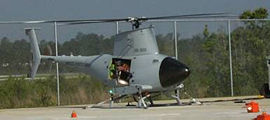MQ-8 Fire Scout: Difference between revisions
imported>Howard C. Berkowitz No edit summary |
imported>Howard C. Berkowitz No edit summary |
||
| Line 4: | Line 4: | ||
| title = MQ-8B Army Fire Scout | | title = MQ-8B Army Fire Scout | ||
| publisher = Northrop Grumman}}</ref> | | publisher = Northrop Grumman}}</ref> | ||
[[Image:ClassIV-01 UAV.jpg|left|270px|thumb|Class IV UAV]] | [[Image:ClassIV-01 UAV.jpg|left|270px|thumb|Class IV UAV]] It will also be deployed on U.S. Navy [[Littoral Combat Ship]]s; three MQ-8's fit into the same space as a MH-60 manned helicopter. | ||
It uses a [[COTS]] airframe that can stay airborne for over 7 hours, and a variety of modular mission packages. The Class IV UAV system, under the [[restructuring of the United States Army]], consists of four Fire Scouts and the associated ground equipment. | It uses a [[COTS]] airframe that can stay airborne for over 7 hours, and a variety of modular mission packages. The Class IV UAV system, under the [[restructuring of the United States Army]], consists of four Fire Scouts and the associated ground equipment. Without human control, it can use unimproved [[landing zone]]s near Corps, Division and Brigade Command Posts and Tactical Operations Centers. | ||
Routinely, it carries electro-optical sensors for the [[visible light]] and [[infrared light|infrared]] spectra, and a combined [[laser rangefinder]] and [[laser designator]]. | Routinely, it carries electro-optical sensors for the [[visible light]] and [[infrared light|infrared]] spectra, and a combined [[laser rangefinder]] and [[laser designator]]. | ||
Revision as of 19:09, 12 April 2009
A rotary-wing unmanned aerial vehicle, the MQ-8 Fire Scout provides surveillance, targeting, communications relay and unmanned logistics delivery for the Future Combat Systems of the U.S. Army, as well as deployment into the Reconnaissance, Surveillance and Target Acquisition Squadron (Brigade Combat Team).[1]
It will also be deployed on U.S. Navy Littoral Combat Ships; three MQ-8's fit into the same space as a MH-60 manned helicopter.
It uses a COTS airframe that can stay airborne for over 7 hours, and a variety of modular mission packages. The Class IV UAV system, under the restructuring of the United States Army, consists of four Fire Scouts and the associated ground equipment. Without human control, it can use unimproved landing zones near Corps, Division and Brigade Command Posts and Tactical Operations Centers.
Routinely, it carries electro-optical sensors for the visible light and infrared spectra, and a combined laser rangefinder and laser designator.
Modular mission packages
- Airborne Surveillance and Target Acquisition Minefield Detection System (ASTAMIDS) sensor
- Tactical Synthetic Aperture Radar (TSAR/MTI)
- Communications relay for communications relay for JTRS and WIN-T
- Mine, Chemical and Radiological detection
- radio frequency direction finder
General information
- Length Folded: 22.87 ft (7.0 m) [1]
- Rotor Diameter: 27.50 ft (8.4 m)
- Height: 9.42 ft (2.9 m)
- Gross Weight: 3,150 lbs (1428.8 kg)
- Engine: Rolls-Royce Model 250-C20W
- Speed: 125+ Knots
- Ceiling: 20,000 ft (6.1 km)
References
- ↑ 1.0 1.1 MQ-8B Army Fire Scout, Northrop Grumman
